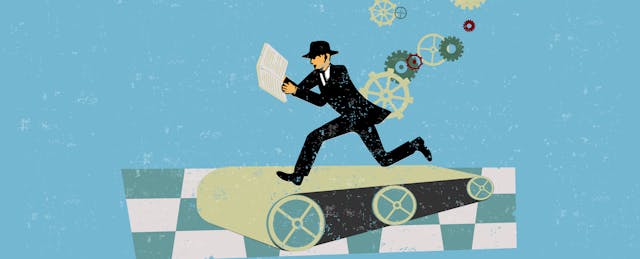In a previous EdSurge piece, I described how economics and technology trends tend to drive educational innovation by providing models that reformers build into their visions, sometimes unconsciously. Architecturally, this plays out in new schools resembling whatever is culturally perceived as representing modernity (the factory in the early 20th century, the Google headquarters today).
It has also impacted the role that teachers play in the mind of educational policy makers and reformers—for good and ill.
A hundred years ago, productivity was correlated to the number of workers one could throw onto an assembly line. In today’s workforce, one employee backed up by teams of experts providing training, tools, just-in-time access to materials and data can perform work that once required dozens of line workers.
There are similar efforts to apply this model of the modern front-line worker, now more productive thanks to technology and coordinated support from highly trained and skilled experts, to the teaching profession.
If you follow the money, the nation has not invested in a massive expansion of the teaching workforce, (which has actually declined slightly over the last ten years), or dramatically increased teacher pay. Rather, investments in education—both public and private—made at the local, state and national level have been spread across a range of activities committed to making the “line teacher” more effective at delivering learning to their “customers” (students).
From this perspective, the strategic use of professional development can be seen as equivalent to the specialized training that workers receive in other industries. Ongoing professional development has been part of the job of teaching for decades, with choices regarding what to prioritize made at the local level. But these decisions that impact districts, schools and teachers increasingly align with strategies set from above, with state and national policy makers shaping priorities through carrots (like funding) and sticks (licensing and accreditation requirements). Investments in teacher training programs when new state standards or social-emotional learning programs are rolled out are recent examples where statewide decisions shape local choices.
One could also look at the thousands of edtech companies and education nonprofits that have sprung up in the last few decades as suppliers of goods and services designed to help teachers perform their work more effectively. Growth of specialist teams dedicated to supporting second-language learners, students with special needs and technology implementation can also be seen as resources put at the disposal of the classroom teachers that help them to do their jobs more effectively.
But the success of such improvement efforts have proven elusive. The problem with applying productivity models that work in other fields to education is that teaching, unlike manufacturing, is not a structured, hierarchical enterprise. Modern businesses make room for, and even rely on, individual initiative from those taking point on the shop floor. But that autonomy is limited, with goals for operations—and strategies designed to achieve those goals—all set from above.
In contrast, the American education system, despite efforts to centralize elements like academic standards, remains enormously fragmented. Goals can vary dramatically from state to state, district to district and even school to school. This is best exemplified by drifts and variations in the implementation of Common Core State Standards, an initiative designed to centralize the needlessly splintered aspects of America’s educational system. Teachers, for the most part, also remain free to use—or not use—resources provided to them, or to customize materials to fit the specific needs of students in widely varying classrooms.
There is obviously nothing wrong with giving teachers access to vast resources—many of them free—designed to make their practice more effective. Historically, however, educational reform has been a road to unintended consequences paved with the best of intentions, with negatives only becoming apparent years after major policy changes have been implemented.
Attempts to make teachers more effective can backfire. Reform burnout is one downside of teachers having to absorb too many initiatives provided by well-intentioned players who want to improve education, but often don’t actually enter the classroom and deal with downstream effects of their policy decisions or “solutions.” Accommodating these efforts can add to the stressful responsibilities that teachers have to juggle that already cause many to leave the profession entirely.
One option that might increase the success of strategies to improve teacher productivity would be to borrow a page from manufacturing and organize schools like modern factories as much as possible. But this would come at the cost of limiting teacher autonomy to certain proscribed tactical areas within a far more centralized system.
Alternatively, we could recognize how current efforts to make teachers more productive fit within competing trends in education, such as the drive for centralized accountability and continued desire for diversity and local autonomy, and create a system where educators at the ground level are empowered to decide what to use and—just as importantly—what not to use from the bounty offered them.
The cost and success rate of solutions and policies based on improving the productivity of individual teachers should also be compared with alternative investments, such as hiring more teachers (and thus reducing class size) and paying the teaching workforce better than we do now. Absent those sorts of commitments, letting well-trained, well-supported teachers decide which methods and tools to prioritize would show them respect by trusting them, more than those outside the classroom, to make the best choices.


